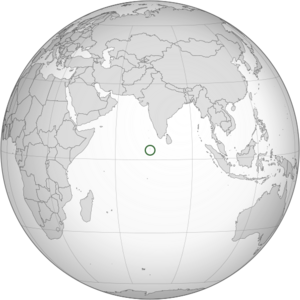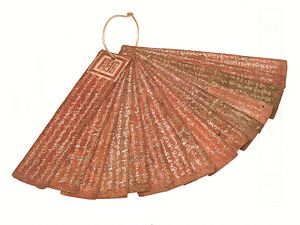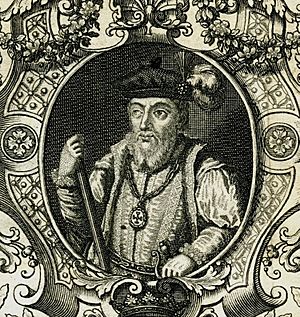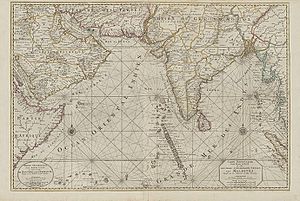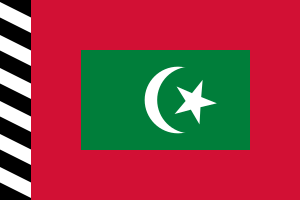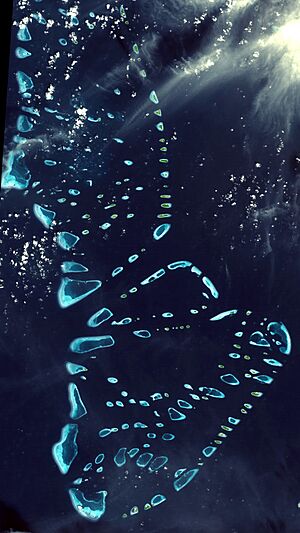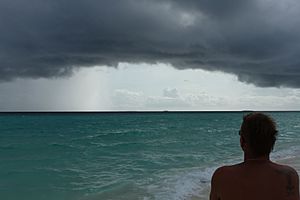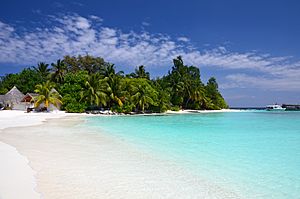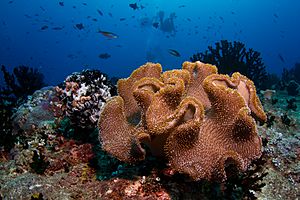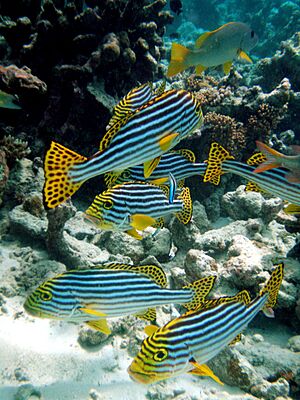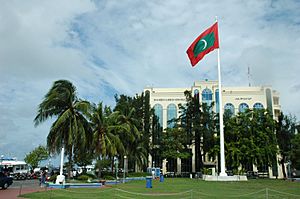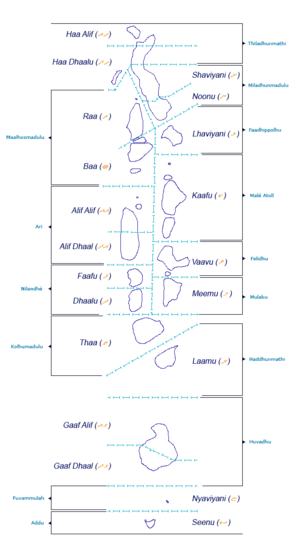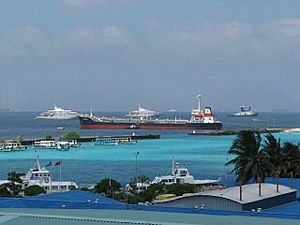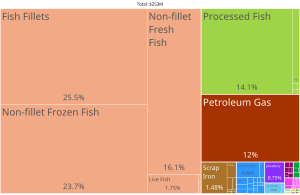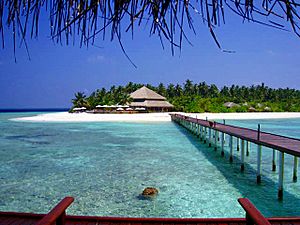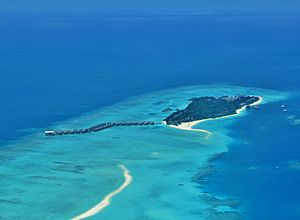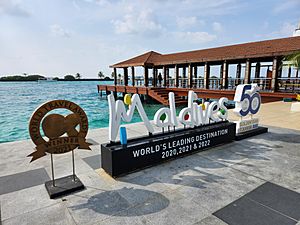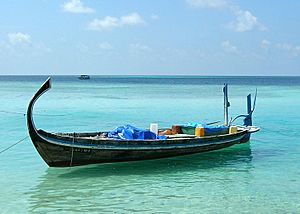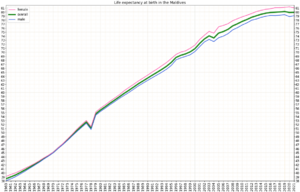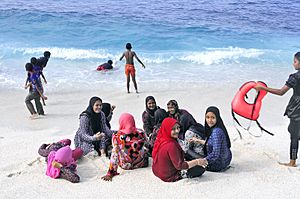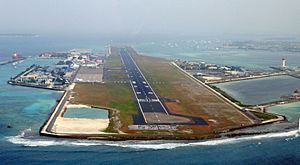Maldives facts for kids
Quick facts for kids
Republic of Maldives
|
|
|---|---|
|
|
|
|
Anthem: ޤައުމީ ސަލާމް (Dhivehi)
Qaumee Salaam "National Salute" |
|
| Capital and largest city
|
Malé 4°10′31″N 73°30′32″E / 4.17528°N 73.50889°E |
| Official language and national language |
Dhivehi |
| Common languages | English |
| Religion | |
| Demonym(s) | Maldivian |
| Government | Unitary presidential republic |
| Mohamed Muizzu | |
| Hussain Mohamed Latheef | |
|
• Majlis Speaker
|
Abdul Raheem Abdulla |
| Legislature | People's Majlis |
| Independence
from the United Kingdom
|
|
|
• Independence declared
|
26 July 1965 |
|
• First Republic
|
1 January 1953 |
|
• Second Republic
|
11 November 1968 |
|
• Current constitution
|
7 August 2008 |
| Area | |
|
• Total
|
298 km2 (115 sq mi) (187th) |
| Population | |
|
• 2022 census
|
515,132 (167th) |
|
• Density
|
1,728.63/km2 (4,477.1/sq mi) (7th) |
| GDP (PPP) | 2024 estimate |
|
• Total
|
|
|
• Per capita
|
|
| GDP (nominal) | 2024 estimate |
|
• Total
|
|
|
• Per capita
|
|
| Gini (2024) | ▼ 31.3 medium |
| HDI (2022) | high · 87th |
| Currency | Maldivian rufiyaa (MVR) |
| Time zone | UTC+5 (MVT) |
| Calling code | +960 |
| ISO 3166 code | MV |
| Internet TLD | .mv |
The Maldives (Dhivehi: ދިވެހިރާއްޖެ, translit. Dhivehi Raajje), officially known as the Republic of Maldives (Dhivehi: ދިވެހިރާއްޖޭގެ ޖުމްހޫރިއްޔާ, translit. Dhivehi Raajjeyge Jumhooriyyaa), is an island nation in South Asia. It is located in the Indian Ocean, southwest of Sri Lanka and India. The Maldives is made up of a chain of 26 atolls that stretch across the equator.
Contents
- Understanding the Name: Maldives
- Maldives History: A Journey Through Time
- Maldives Geography: Islands and Atolls
- Government and Administration
- Maldives Economy: From Shells to Tourism
- People of the Maldives
- Culture: A Mix of Influences
- Transportation: Getting Around the Islands
- Education: Learning and Growing
- Images for kids
- See also
Understanding the Name: Maldives
The name Maldives might come from ancient words. Some believe it comes from the Sanskrit words mālā (meaning "garland") and dvīpa (meaning "island"). This would make it "Garland of Islands." In Sinhala, it's similar: Maala Divaina, also meaning "Necklace Islands."
The people of the Maldives are called Dhivehin. The word Dheeb or Deeb means "island," so Dhivehin means "islanders."
Maldives History: A Journey Through Time
The Maldives has a very long history, going back over 2,500 years!
Ancient Times and First Settlers
The first people to settle in the Maldives were likely from India, possibly around 500 BCE. Ancient records show that kingdoms existed here as early as the 6th–5th century BCE. Some historians think people might have lived here even during the Indus Valley Civilisation (3300–1300 BCE). Old items found in the Maldives also show that Hinduism was present before Islam arrived.
The first settlers were known as Dheyvis, who came from Kalibanga in India. Their buildings were probably made of wood and palm leaves, which decayed over time. This is why we don't find many ancient structures.
The Buddhist Era: 1,400 Years of Culture
For about 1,400 years, Buddhism was the main religion in the Maldives. This period was very important for the country's culture. The Dhivehi language, early writing styles, architecture, and customs all developed during this time.
Buddhism likely came to the Maldives around the 3rd century BCE. Ancient Maldivian kings supported Buddhism. Most old buildings and items found from this time are Buddhist stupas (dome-shaped structures) and monasteries.
The Islamic Period: A New Chapter
Around the 12th century, the last Buddhist king of the Maldives, Dhovemi, converted to Islam. He took the Muslim title Sultan Muhammad al-Adil. This started a long line of Islamic rulers that lasted until 1932.
A Muslim traveler from Morocco, Abu al-Barakat Yusuf al-Barbari, is traditionally given credit for this change. His tomb is now in Malé, near the Hukuru Miskiy, which was built in 1656 and is the oldest mosque in the Maldives.
Islam became the official religion, and Arabic became an important language for government. The Maldives was one of the last places in South Asia to convert to Islam. Arab traders found the Maldives important for trade routes, especially for cowrie shells (used as money) and coir (coconut fiber for ropes).
Becoming a British Protectorate
In 1558, the Portuguese set up a small trading post in the Maldives. However, their attempts to force Christianity led to a local uprising. Muhammad Thakurufaanu al-Auzam and his brothers drove the Portuguese out after 15 years. This event is celebrated as National Day.
Later, in the mid-17th century, the Dutch took control of affairs from Sri Lanka. Then, in 1796, the British took over from the Dutch. In 1887, the Maldives officially became a British protectorate. This meant Britain handled the Maldives' foreign relations and defense, but the islands kept their own local rule based on Islamic customs.
During the British period, the Sultan's power lessened, and the Chief Minister became more powerful. Britain encouraged a constitutional monarchy, and the first constitution was created in 1932.
In 1953, the sultanate was paused, and the First Republic was declared with Muhammad Amin Didi as president. He worked to improve education and women's rights. However, his government was removed, and he died during a riot. The sultanate was restored in 1954.
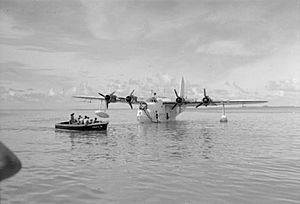
From the 1950s, the British military had a base in Addu Atoll. This base brought jobs, but also led to a local group trying to break away from the Maldives government. This group formed the United Suvadive Republic in 1959, but it was stopped by the government a year later. The British base closed in 1976.
Independence and the Republic Today
On 26 July 1965, the Maldives gained full independence from the United Kingdom. The sultanate continued for three more years under Sir Muhammad Fareed Didi.
In 1967, parliament voted to become a republic, and in 1968, a national vote confirmed this. The republic was declared on 11 November 1968, ending the monarchy. Ibrahim Nasir became the first president.
In the early 1970s, tourism began to grow. The first resort opened in 1972. This helped the country's economy a lot. The Maldives later became a founding member of the South Asian Association for Regional Cooperation (SAARC).
Maldives Geography: Islands and Atolls
The Maldives is made up of 1,192 coral islands. These islands are grouped into 26 atolls, stretching about 871 kilometers (541 miles) from north to south. Only 298 square kilometers (115 square miles) of this area is dry land, making it one of the most spread-out countries in the world.
The atolls are made of live coral reefs and sand bars. They sit on a long underwater ridge that rises sharply from the deep Indian Ocean. The Maldivian government has divided these atolls into 21 administrative areas. The largest island is Gan.
The Maldives is the lowest country in the world. Its highest natural point is only about 2.4 meters (7 feet 10 inches) above sea level. More than 80% of the land is less than one meter (3 feet 3 inches) above sea level. This means the Maldives is very vulnerable to rising sea levels.
Climate: Tropical and Humid
The Maldives has a tropical monsoon climate. This means it's always hot and often humid. The weather is mainly influenced by two seasons: the dry season (from December to April) and the rainy season (from May to November). The rainy season brings strong winds and storms.
The average high temperature is 31.5 degrees Celsius (88.7 °F), and the average low is 26.4 degrees Celsius (79.5 °F).
Rising Sea Levels: A Big Challenge
Because the Maldives is so low, rising sea levels are a major concern. Experts have warned that much of the country could become uninhabitable by 2100 if sea levels continue to rise at current rates.
Former President Mohamed Nasheed even suggested buying new land in other countries like India or Australia. He wanted to avoid Maldivians becoming "climate refugees." He also held an "underwater cabinet meeting" in 2009 to raise awareness about climate change.
Recent studies suggest that tides might help islands build up sediment, which could help them adapt to rising sea levels. However, human-made structures like sea walls can prevent this natural adaptation.
Environmental Concerns
Besides rising sea levels, the Maldives faces challenges with waste disposal and sand theft. Most waste from the capital, Malé, and nearby resorts goes to Thilafushi, an industrial island built on a reclaimed lagoon.
The Maldives has 31 protected areas to help preserve its natural beauty.
Amazing Marine Life
The Maldives is home to an incredible variety of marine life. Its coral reefs are made up of 187 different coral species. The Indian Ocean here has 1,100 species of fish, 5 types of sea turtle, and 21 species of whales and dolphins. You can also find many types of mollusks and echinoderms.
Common fish include pufferfish, lionfish, reef sharks, groupers, eels, and many colorful butterflyfish and angelfish. You might also spot spotted eagle rays and lobsters.
In 1998 and again in 2016, warm ocean temperatures caused coral bleaching, which damaged many coral reefs. Scientists are working to help the reefs recover.
Government and Administration
The Maldives is a presidential constitutional republic. This means the president is both the head of government and the head of state. The president leads the government and the armed forces. The president and members of the People's Majlis (Parliament) serve five-year terms.
Administrative Divisions: How the Islands are Organized
The Maldives has 26 natural atolls. These are divided into 21 administrative areas, including 17 administrative atolls and the cities of Malé, Addu, Fuvahmulah, and Kulhudhuffushi.
Each atoll and island has its own elected council to manage local affairs. Each administrative division has a Maldivian code letter (like "Haa Alif") and a Latin code letter. These codes help avoid confusion because some islands in different atolls have the same name.
Maldives Economy: From Shells to Tourism
Long ago, the Maldives was famous for its cowry shells, which were used as money around the world. From the 2nd century CE, Arabs called the islands the "Money Isles." Today, the cowry shell is a symbol of the Maldives Monetary Authority.
In the early 1970s, the Maldives was one of the poorest countries. Its economy relied on fishing and trading local goods like coir rope.
In the 1980s, the government started economic reforms, opening up more opportunities for private businesses. This was when the tourism industry began to grow, which would become very important.
Farming and manufacturing are smaller parts of the economy because there isn't much land for farming and not enough local workers.
Tourism: A Major Industry
The Maldives was not well-known to tourists until the early 1970s. Only 189 of its islands are home to people. The other islands are used for economic activities, mainly tourism and agriculture.
Tourism now makes up 28% of the country's GDP (Gross Domestic Product) and brings in over 60% of its foreign money. More than 90% of government tax income comes from tourism-related taxes.
The first tourist resorts opened in 1972, including Bandos Island Resort and Kurumba Village. These resorts changed the Maldives' economy, making tourism the main source of income. By 2008, there were 89 resorts, and in 2019, over 1.7 million visitors came to the islands.
The Maldives also has six historic coral mosques listed as potential UNESCO World Heritage Sites.
Visiting the Maldives
Most visitors to the Maldives do not need a visa before arriving. They just need a valid passport, proof of onward travel, and enough money for their stay.
Most international flights arrive at Velana International Airport, which is near the capital city, Malé. This airport has flights from India, Sri Lanka, Dubai, Singapore, and major European cities. Gan International Airport in the south also has international flights.
Fishing Industry: A Traditional Livelihood
For many centuries, the Maldivian economy depended entirely on fishing. Fishing is still a main job for many people, and the government supports this industry.
A big step for the fishing industry was when traditional fishing boats, called dhonis, were mechanized in 1974. A fish canning plant was built in 1977. The government also set up a Fisheries Advisory Board to guide the industry's development.
As of 2010, fishing contributed over 15% of the country's GDP and employed about 30% of the workforce. It was also the second-largest source of foreign money after tourism.
People of the Maldives
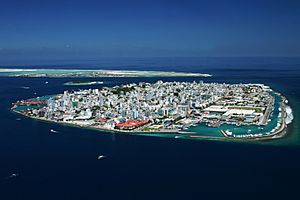
| Year | Population |
|---|---|
| 1911 | 72,237 |
| 1966 | 100,883 |
| 2000 | 270,101 |
| 2020 est. | 557,426 |
The largest ethnic group in the Maldives are the Maldivians. They share the same culture and speak the Dhivehi language. Their background includes influences from the Middle East, South Asia, Southeast Asia, and Africa.
There used to be a small Tamil population called the Giraavaru people, but they have mostly blended into Maldivian society.
Society in the Maldives has some social levels, but they are not strict. Rank is based on things like job, wealth, and family ties. People are generally divided into noble and common people. Most of the social elite live in Malé.
The population of the Maldives has grown a lot. In 1978, it was 100,000, and by 2006, it reached almost 300,000. Life expectancy has also greatly improved, from 46 years in 1978 to 72 years today. Infant mortality has dropped significantly, and almost everyone can read and write.
As of May 2021, there were about 281,000 foreign workers in the Maldives, mainly from Bangladesh, India, Sri Lanka, Nepal, and China.
Religion: Islam in the Maldives
After a long Buddhist period, Muslim traders brought Islam to the Maldives. Maldivians converted to Islam by the mid-12th century.
Today, Islam is the official religion for everyone in the Maldives. To be a citizen, you must follow Islam. The country has a history of Sufi traditions, which included special ceremonies.
The person credited with bringing Islam to the Maldives is Abu al-Barakat Yusuf al-Barbari, a Sunni Muslim traveler. His tomb is a respected site in Malé, next to the Hukuru Miskiy, the country's oldest mosque, built in 1656.
Languages: Dhivehi and English
The official and national language is Dhivehi. It is an Indo-Aryan language that is closely related to the Sinhala language of Sri Lanka.
The earliest known script for Dhivehi was eveyla akuru. Later, dhives akuru was used. The script used today is called Thaana, and it is written from right to left.
English is also widely spoken in the Maldives. It is used in schools and is important for the tourism industry.
Culture: A Mix of Influences
The culture of the Maldives has been shaped by different groups of people who have settled on the islands over time.
Since the 12th century, there have been influences from Arabia on the language and culture. This is because of the conversion to Islam and the Maldives' location as a trading hub in the Indian Ocean.
Transportation: Getting Around the Islands
Velana International Airport is the main airport for the Maldives. It is next to the capital city, Malé, and connected by a bridge.
There are three main ways to travel between the islands:
- Domestic flights: Government-owned Island Aviation Services (Maldivian) operates flights to nearly all domestic airports.
- Seaplanes: Companies like TMA (Trans Maldivian Airways) and Manta Air use seaplanes to fly guests directly to resort islands.
- Boats: Traditional Maldivian boats called dhonis are used for slower, cheaper travel. Speedboats are also available for faster transfers.
Several daily flights operate from Velana International Airport to the 18 domestic and international airports in the country. Scheduled ferries also connect Malé to many atolls.
Education: Learning and Growing
The Maldives National University is one of the country's main higher education institutions. Over the years, various centers were created to train people for different jobs, such as health services, mechanical trades, teaching, hotel services, and management.
In 1998, the Maldives College of Higher Education was founded, offering its first degree program in 2000. In 2011, this college became the Maldives National University. In 2015, the College of Islamic Studies became the Islamic University of Maldives (IUM).
Images for kids
-
An RAF plane at Addu Atoll during WWII.
See also
 In Spanish: Maldivas para niños
In Spanish: Maldivas para niños
- List of Maldives-related topics
- Outline of Maldives
- Maldives Sign Language
- Maldives Inland Revenue Authority




